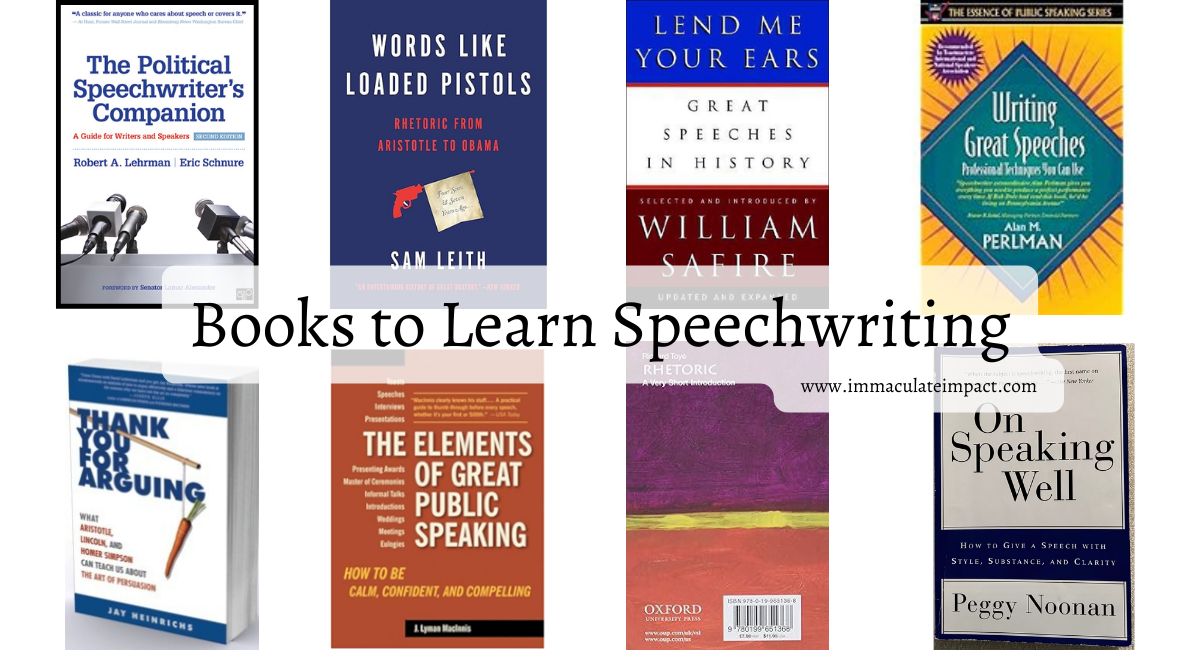20 Most Famous Books to Learn Speechwriting that Every Speech Guru Has Read
Speechwriting is a special kind of writing that blends storytelling persuasion and clear communication. Numerous Books to Learn Speechwriting written by professionals in the field offer insights into the craft that you can read if you’re looking to improve your abilities.
Table of Contents
From the personal tales of seasoned professionals to useful tips for organizing and giving speeches each offers distinctive insights. These books will help you hone your abilities and enthrall your audience whether you’re a novice or an accomplished speechwriter.
This is a thorough list of speechwriting books complete with a synopsis and author details publication year and location.
Top 20 Books to Learn Speechwriting:
1. “The Political Speechwriter’s Companion: A Guide for Writers and Speakers” by Robert Lehrman

- Year: 2009
- Publication location: Washington D.C.
- Description: This book provides helpful advice on crafting impactful political speeches. Lehrman dives into the subtleties of speechwriting offering strategies and examples to make speeches memorable. Lehrman previously worked as Vice President Al Gore’s speechwriter in the White House.
- Why Read It: Political communicators and others who want to comprehend the tactics of political speech will find it particularly helpful.
2. “Words Like Loaded Pistols: Rhetoric from Aristotle to Obama” by Sam Leith

- Year: 2012
- Publication location: London UK.
- Description: Explaining how antiquated methods continue to influence contemporary speeches Leith explores the history of rhetoric. The book highlights how persuasive communication is ageless citing everything from Aristotle’s ideas to Barack Obama’s speeches.
- Why Read: This book gives readers useful advice for creating strong speeches while teaching them to recognize the power of rhetoric.
3. “Lend Me Your Ears: All You Need to Know about Making Speeches and Presentations” by Max Atkinson

- Year: 2005
- Publication Location: The publication was done in Oxford UK.
- Description: Atkinson, a political speechwriter and presenter extraordinaire offers a thorough how-to manual for crafting captivating speeches. His topics range from speech organization to captivating audience dynamics during delivery.
- Why Read: Ideal for individuals in need of a hands-on comprehensive manual for creating speeches or presentations.
4. “Writing Great Speeches: Professional Techniques You Can Use” by Alan M. Perlman

- Year: 1998
- Publication location: Boston USA.
- The craft of crafting speeches that effectively connect with audiences is the main focus of Perlman. He offers methods for gathering information, structuring thoughts and adding distinctive elements to speeches.
- Reason to Read: An extensive and well-organized manual for both novices and experts.
5. “Thank You for Arguing: What Aristotle, Lincoln, and Homer Simpson Can Teach Us About the Art of Persuasion” by Jay Heinrichs

- Year: 2007
- Publication Location: New York USA
- Description: Heinrichs uses rhetoric to introduce readers to the craft of persuasion. In addition to historical examples and useful tips on persuading any audience the book is jam-packed with rhetorical devices.
- Why Read? Using humor and real-world examples it provides an enjoyable and approachable introduction to persuasion while teaching speech writing techniques.
6. “The Elements of Great Public Speaking” by J. Lyman MacInnis

- Year: 2006
- Publication location: New York USA
- Description: MacInnis provides a succinct manual for becoming an effective public speaker. The book discusses important speech writing topics like tone and structure even though its main focus is on delivery.
- Why Read: Excellent for readers who wish to sharpen their delivery and speechwriting abilities.
7. “Rhetoric: A Very Short Introduction” by Richard Toye

- Year: 2013
- Publication location: Oxford, United Kingdom.
- Description: Toye offers a clear introduction to rhetoric, the foundation of any well-crafted speech. He gives helpful tips for creating strong speeches and discusses the historical applications of rhetoric.
- Why Read It? This book is a great place to start for anyone who wants to learn about the theoretical and historical foundations of speechwriting.
8. “On Speaking Well: How to Give a Speech with Style, Substance, and Clarity” by Peggy Noonan

- Year: 1998
- Publication location: USA New York
- Description: Noonan, a former speechwriter for Ronald Reagan offers advice on how to write speeches that connect. She places a strong emphasis on substance style and clarity while offering readers timeless guidance on audience engagement.
- Why Read: Written by one of the most well-known speechwriters in contemporary American politics this book combines candid personal tales with helpful advice.
9. “The King’s Speech: How One Man Saved the British Monarchy” by Mark Logue and Peter Conradi

- Year: 2010
- Publication Location: The publication was done in London, UK.
- Description: This book offers insights into the significance of speechwriting and delivery in historical contexts based on the tale behind King George VIs well-known speech. It also provides guidance on how to get over feelings of insecurity and fear.
- Why Read: This isn’t your typical speech writing handbook but it is an interesting case study of how a well-written speech can alter history.
10. “Made to Stick: Why Some Ideas Survive and Others Die” by Chip Heath and Dan Heath

- Year: 2007
- Publication location: New York USA.
- Description: The main topic of this book is the reasons behind the greater memorability of certain concepts and consequently speeches. The Heath brothers provide a method for helping audiences remember speeches.
- Why Read: Speechwriters who want to craft powerful lasting messages should read this.
11. “Speechwriting: The Expert Guide” by Simon Lancaster

- Year: 2010
- Publication location:The publication was done in London, UK.
- Description: Professional speechwriter Lancaster offers insider advice on creating speeches that grab listeners attention. He goes over every topic imaginable including the principles of rhetoric and speech delivery techniques.
- Why Read: If you want to get better at giving speeches that are both more engaging and well-performed this is a great resource.
12. “The Writing of Speeches” by J.A. Winans
- Year: 1915
- Publication location: USA New York.
- Description: This timeless manual covers the fundamentals of speechwriting with an emphasis on the organization, articulation and use of rhetoric. The guidance is still applicable to anyone trying to become an expert speechwriter even though it is older.
- Why Read: This book offers timeless guidance for anyone interested in the history of speechwriting.
13. “The Art of Public Speaking” by Dale Carnegie

- Year: 1915 (available in revised editions).
- Publication Location: New York USA.
- Description: This book is regarded as a classic in the field of public speaking because it offers helpful guidance on captivating audiences. Although it covers how to write effective speeches it is primarily concerned with delivery.
- Why Read: This text is essential reading for anybody interested in speechwriting and public speaking.
14. “Lincoln’s Sword: The Presidency and the Power of Words” by Douglas L. Wilson

- Year: 2006
- Publication Location: New York USA.
- Description: This literary work examines the most well-known speeches delivered by Abraham Lincoln delving into his use of language to influence the course of the country. A thorough examination of the historical impact of speechwriting is provided.
- Why Read: Those interested in learning from one of the greatest American speechwriters and history buffs should not miss this important work.
15. “Rhetorical Style: The Uses of Language in Persuasion” by Jeanne Fahnestock

- Year: 2011
- Publication location: New York USA.
- Description: This book explores the stylistic elements of rhetoric and provides in-depth advice on how to use language persuasively. It approaches the craft of speechwriting in a more scholarly manner.
- Why Read: Excellent for individuals who wish to learn more about the linguistics of speeches.
16. “Speak Like Churchill, Stand Like Lincoln: 21 Powerful Secrets of History’s Greatest Speakers” by James C. Humes

- Year: 2002
- Publication Location: New York USA.
- Description: Humes offers insights from some of the greatest orators in history such as Abraham Lincoln and Winston Churchill. The book provides helpful guidance on how to apply these strategies in contemporary speeches.
- Why Read: This highly approachable manual teaches effective speech writing by using historical examples.
17. “How to Write a Speech” by Leslie Harper

- Year: 2015
- Publication location: New York USA.
- Description: Harper provides an easy-to-read and useful manual for anyone who needs to write speeches fast and well. Speech structure content development and audience engagement are all covered in this book.
- Why Read: Excellent for novices or those seeking immediate practical guidance on crafting a coherent speech.
18. “The Speechwriter: A Brief Education in Politics” by Barton Swaim

- Year: 2015
- Publication location: USA New York.
- Description: An insider’s perspective of life as a political speechwriter is offered in this memoir. By chronicling his tenure as a top political staffer Swaim provides an intimate glimpse into the inner workings of the speechwriting profession.
- Why Read: This memoir-in-instruction blend provides a distinctive viewpoint on the difficulties and benefits of speechwriting for politicians.
19. “Mastering the Art of Oral Presentations: Winning Orals Tips & Techniques” by John A. Zisk

- Year: 2015
- Publication location: Published in Boston USA.
- Description: Although Zisks’ book primarily focuses on oral presentations it offers important tips for creating speeches that work for any audience. It places a strong emphasis on speech organization for maximum impact clarity and audience participation.
- Why Read: Excellent for anyone wishing to hone their public speaking and speechwriting abilities particularly in formal or business contexts.
20. “The Presentation Secrets of Steve Jobs: How to Be Insanely Great in Front of Any Audience” by Carmine Gallo

- Year: 2009
- Publication location: New York, USA is the publication place.
- Description: This book dissects the strategies Steve Jobs employed to give gripping speeches and presentations. Gallo focuses on the persuasive strategies, storytelling devices and visual aids that distinguished Jobs’ presentations.
- Why Read: The book offers a comprehensive examination of a skilled orator demonstrating the art of creating speeches and presentations that create a memorable impact.
Conclusion
In conclusion, The skill of crafting a speech involves striking a balance between facts and feelings structure and spontaneity and persuasiveness and clarity. The aforementioned books offer a wide range of viewpoints on the craft covering everything from the theoretical underpinnings of rhetoric to helpful practical guidance for contemporary speechwriters.
These resources can help you improve your speech skills or just get started by providing insightful information about what makes a speech truly memorable. These books will be indispensable tools in your quest to create speeches that are powerful and impactful whether you are writing for a political figure, a business presentation or just to get better at public speaking.






